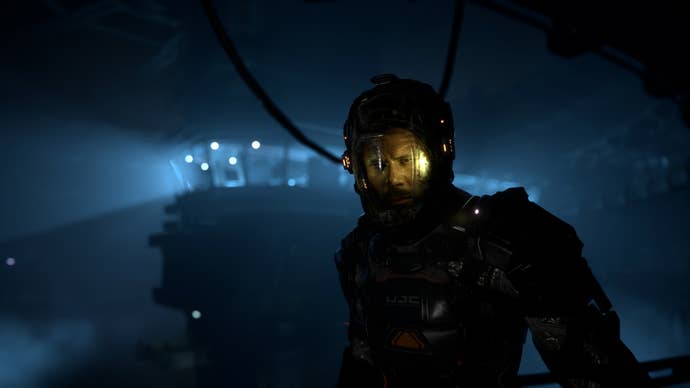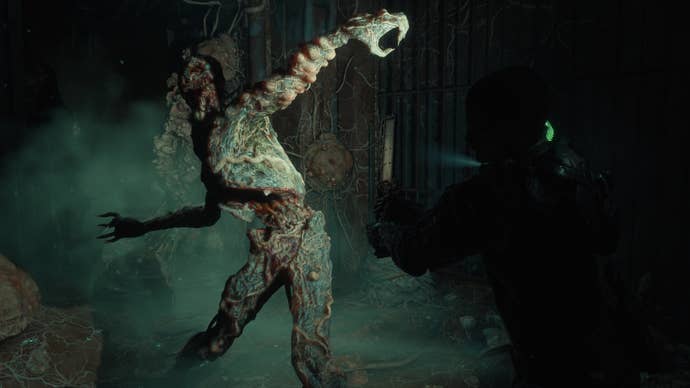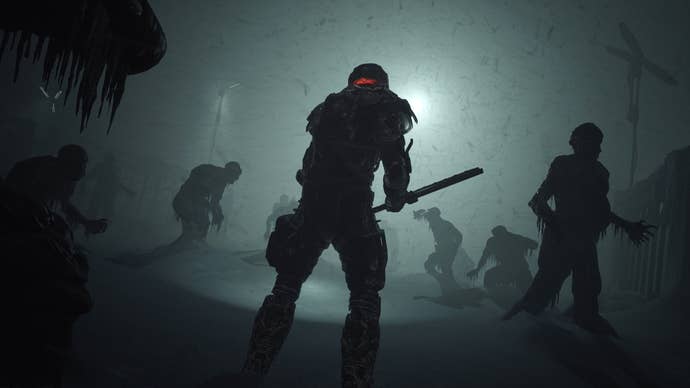The twist here is that enemies in The Callisto Protocol can mutate.
After you engage them in combat some tentacles will start spurting out of their torso.
“Especially with a sort of survival horror game - you’ve got a bunch of different weapons.

I’ve always believed that survival horror doesn’t mean you would just have one bullet, right?
Schofield describes your options as “a pretty extensive arsenal” here.
Some of them are for searching for stuff.

Some of them just fill in the blanks a little bit.
We have one that has a pretty grotesque shower” - and then a spot of that upgrading.
Schofield enjoys talking about your options here.

you could also pick them up and use them as a meat shield - but watch out!
Because the guy shooting is going to cut off the legs and arms.
So they’re not going to be much of a meat shield after a while."

“You’re gonna want to probably go for the closest one, right?”
“Try and take him out as soon as possible.
Because he’s got really good accuracy.

And he’s not shooting out, like, bullets or anything.
He’s shooting out a giant parasite.
So it lands on you.

He might call it cinematic.
He talks about getting the balance right when trying to bring that through in the game.
“I know there’s my style in there.

So I’ve consciously tried to change things up a little bit.
“I’m like, why can’t I have a stomp?
You know, why can’t I have dismemberment?

Every other game since our game [Dead Space] put dismemberment in.
So yeah - at first they said “nothing from Dead Space, nothing!”
“There’s been a lot of similarities that people have been talking about.
But I think if you play the game, you’ll feel it’s different.
Last time I made Dead Space, Left for Dead was coming out.
And they both had severed arms on the front.
And they both had “Dead” in it.
And they were both from EA!”
“I went to EA and I’m like: what are you thinking?!
And they were like: “well, we’re putting ‘em both out.”
So every game I make has competition.
So I stopped worrying about it.
I just focus on making the best game, the vision of the game that we have.”
“Comedy and horror, they’re strange cousins.
When I’m setting up a suspense sequence, I find it very similar to setting up a joke.
They’re similar in terms of construction, setup and payoff.
A scream and a laugh are both involuntary reactions.
I’m a big coward.”
“He [the main character] has some lines here and there.
You got to be careful because we had too many of those lines at one point, right…
Here comes a scare.”
You don’t want to set up any patterns in a horror game.
Or if you do set a pattern, you want to screw with that pattern, like ah!
We didn’t put anything there!”
“It’s hard.
It’s hard engineering.
It comes from the gut.
But then maybe next time I scare you within two seconds.
So no rules.”
“What we’ve had to do is find new things in music, new trends.
We use what’s called the Apprehension Engine.
It’s this crazy instrument that just makes weird sounds.
We picked it up from Hollywood.
“And you’re like - what was that?!
It makes your hair stand up on your arms, you know?”
He elaborates again later on, when asked about combating staleness for those overfamiliar fans.
It probably also comes back to Schofield’s style, and to his attitude as a whole.
“We [are] working six-seven days a week, nobody’s forcing us.
Exhausted, tired, covid, but we’re working.
Bugs, glitches, perf fixes.
One last pass through audio.
Lunch, dinner, working.
You do it cause ya luv it.”
The Callisto Protocol feels like a game from 2010, in many ways.
But there are a few things from that era of games that are far better left behind.